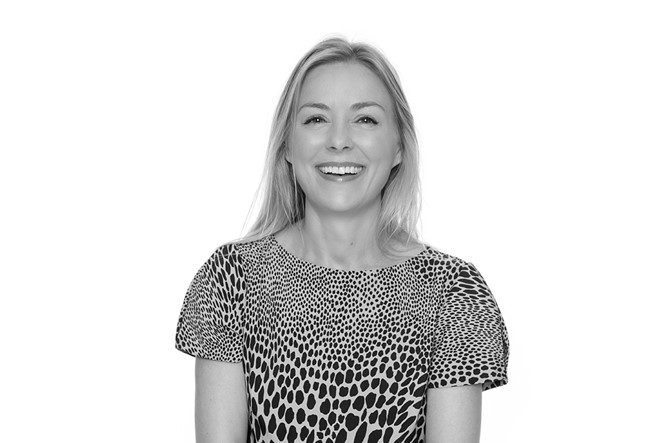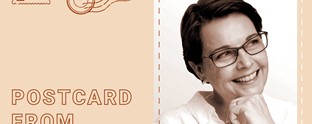Three decades and counting: Wolff Olin’s first female global CEO interviewed

From an eclectic upbringing to being the first female CEO of one of the most iconic brand consultancies, Sairah Ashman has undoubtedly climbed her way up. Elettra Scrivo caught up with her to discuss her three-decade career at Wolff Olins.
When Sairah Ashman first began at Wolff Olins 27 years ago, by ‘serendipity to some degree,’ as she describes it, she had not intended to become its first female global CEO. In fact, she hadn’t even planned to stay at the agency for more than a few years.
“Like most people, I joined Wolff Olins thinking it was a career move, and that after having banked my couple of years, I’d think of where to go next to make my way up,” says Ashman. Sure enough Ashman had a job offer from a prestigious competitor after a couple of years at Wolff Olins. However, she turned down it and decided to stay put.
“A senior person I was working with to told me there was still so much more I could learn at Wolff Olins. I’m very curious by nature and I like learning new things so I decided to stay. I spent the next few years soaking up as much knowledge as I could and I realised the culture of Wolff Olins suited me perfectly. The work environment and the people I spend time with everyday are very important to me. Wolff Olins had, and still has, very high standards, a disruptive ambition and a vanguard spirit. I trusted I could undoubtedly have an impact on the things I’d like to change and make it even better in the future” Ashman says.
Founded in 1965 by brand design legends Michael Wolff and Wally Olins, Wolff Olins was then sold to the Omnicom Group in 2001. It currently counts 150 employees across its London, New York City and San Francisco Offices. The global brand consultancy has been at the helm of some of the most innovative brand design projects, including The Beatles’ record label, Apple Records, in the 60s, the London 2012 Olympics, Orange, BT and TikTok more recently. The avant-garde, optimistic and ambitious spirit that characterised the firm since its inception in the 60s, has not changed, Ashman says.
“Our ‘why’ and what we value most doesn’t change too much, although we may use different words to describe it. We’ll always be creating the kind of powerful shifts and unconventional creative leaps that move things forward positively for as many people as possible. You can tell the agency was born in the 60s because it has this incredible attitude of ‘the world should be better tomorrow than it is today- how are going to help make that happen?’” she says.
While Ashman has now found a place of belonging, becoming a leading figure in brand design was not her initial plan. Ending up in a design agency with her first job was ‘rather random,’ as she puts it. The daughter of a hippie, Ashman had an atypical and eclectic upbringing, one that people would not usually associate with that of a CEO. Always doing school around other things as she travelled around with her mother, she left education completely just before her 16th birthday. “I couldn't see myself doing another six years of education straightforwardly and then coming out with a degree afterwards. I was just hungry to experience the world and get started.”
“After a few years working in other sectors, I realised that design was the perfect fit for me because it was doing creative problem-solving in both a visual and a strategic sense. The first agency I worked for was very multidisciplinary so when when we talked about design, we referred to corporate identity design, as it was called then. We also dealt with packaging design events, and retail experiences. I got a kind of baccalaureate in design, understanding what it would be like to work in lots of different disciplines within the realm,” she adds.
Looking to experience this multidisciplinary approach even within Wolff Olins led Ashman to not always have a straightforward journey. In fact, she returned to formal education mid-career. She first went to Harvard Business School to sharpen her business leadership sills and then to Goldsmith’s University for a part-time Masters in Digital Sociology.
“My journey has been influenced by the thought, ‘I want to learn this and I want to be able to do that or I haven't got enough power to be able to influence this.’ My progress at Wolff Olins was never dictated by the idea of getting from one position to the next. Rather, I’ve always thought of how I could grow my skill set or have more influence in a certain area. That has naturally taken me on the journey that I've been on.”
A 27 year journey, which culminated in Ashman becoming the first global female CEO in 2017. Before then, she went from being the senior account director, to the head of client services to the first MD in London, another big moment for the gender equality movement in brand design. All these firsts (Ashman was also the first female global COO) have not only shaped her career, but also helped her work on building a fairer and more equal culture at Wolff Olins.
For Ashman, it’s not just about hiring more women or promoting them to senior positions, but creating the right environment to propagate diversity, allowing women to thrive. “Many women are going to step away from the business for a while after having children. We need to focus on how the company can make them feel like that they will still be connected to the organisation and able to progress in their career once back. It’s important to me that other women know they can go all the way to the top like I have, without compromising who they are or what they believe.”
The increase in number of women in senior positions is only one of the many changes Ashman has witnessed over the past three decades at Wolff Olins. The agency has evolved exponentially to keep up with the pace as the rest of the world around it changed.
“We’ve broadened some of the capabilities we have. Once upon a time, brand was categorised as design and identity with some strategy to back it up. Now it's more around the experience of brand both externally and internally. The definition of brand is much broader today than it ever was. All those years ago, brand was almost being taught for the first time and there weren’t many of us who were professionals at it. Whereas now, it’s a proven discipline, ” Ashman says.
The advent of the internet also helped fuel many changes. As a ‘pre-internet’ person, Ashman witnessed both sides of things. “The internet just flattened everything out, making it much easier to reach more and more people. We had never experienced something like that. Power shifted dramatically from a few people being able to have a say, to a lot of people voicing their thoughts, which was really positive,” she says.
In addition to a sense of democratisation, the internet also brought along more awareness, on both the brand and consumer side. As people were increasingly connected and aware of what was happening around the world, they sought out brands that had authenticity and purpose at the heart of their ethos. Social justice issues became something brands were expected to take into account. In line with this, Wolff Olins came up with the ‘conscious brand’ philosophy, to help itself and its clients stay true to their values.
“We see building conscious brands as being two sides of the same coin. On one side, it’s about being very responsible – to become more ethical, sustainable and prepared to make tough calls on moral and social issues. On the other, it’s about being responsive, open but empathetic and more attuned to peoples’ shifting identities, moods and cultures. Brands who play at this responsive and responsible intersection are more conscious of both their impact and of the people they serve,” Ashman says.
It’s for values like the ‘conscious brand’ that Ashman has still not left the agency after almost thirty years, not even to move in-house. Although she acknowledges the satisfaction of building a brand over time and across different aspects as one would on the client side, she feels her current role at Wolff Olins fulfils both sides of the job.
“Once I started moving into more senior roles and shaping the agency, I struck a great balance of building our own business while staying close to the big shifts happening for our clients in the world. We often get to see how whole industries are changing and new categories are being formed before anyone else – it keeps things fresh and exciting,” she says.
While the future is never certain, Ashman can see herself staying at Wolff Olins for a long time. She still values the agency’s qualities that attracted her in the first place all those years ago, and that allowed her to build a successful career in brand design. “Joining Wolff Olins is like joining the brand marines – you’ll never be pushed harder, fulfil more of your potential or make more meaningful friendships. For many of us it’s life changing.”












